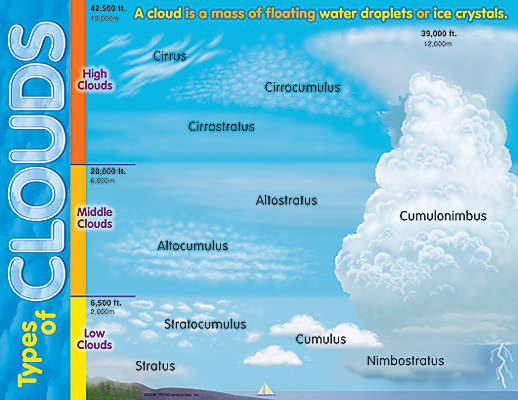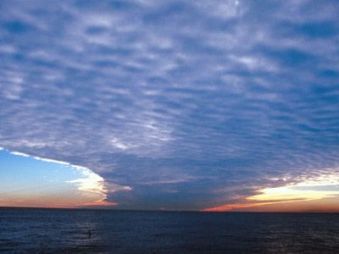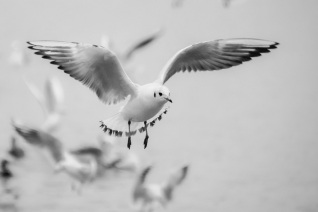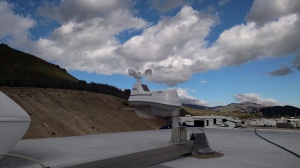April Showers, May Flowers. It’s that time when brighter days and the abundance of blooming flowers charm us to outdoor adventures. Day out on the lake, picnics by the lake, and road trips to flower fields can be met with rainy surprises. With chances of light drizzles, sunny days and breezy evenings, enjoy by being safe on your boat trips by preparing for the unexpected weather changes that come during the spring season.
Be Aware of Swift Weather Changes While Out in Your Boat
You want to be careful of boating in any conditions of rain, even on light-drizzles. The weather can change quickly and if caught unprepared it can lead to dangerous situations. This is why the Coast Guard insists boating operators learn to read signs of the weather, paying particular attention to subtle signs. The most important aspect for boaters to watch out for and be aware of is the clouds: how fast are the clouds moving? What shape and color are the clouds? The clouds will give a great indication to boaters if that light drizzle is the doorstep to the storm’s arrival or if it is just spring’s last rainy “hurrah” before retiring in the wake of summer.
Check the Clouds While on Your Boat

While there are many cloud-types, there are 4 in specific that Boaters should be aware of when out in the water.
Cirrus Clouds
 These are clouds that are extremely high in elevation, reaching up to 42,000 feet. Cirrus Clouds are thin and whispy and appear abnormally far away when viewed from below. Cirrus Clouds may appear harmless in their appearance but be careful of these high clouds, sometimes they appear just before snowfall and rainfall. Their appearance looks thin because they are made of ice crystals rather than water drops in cold temperatures. If they appear against blue skies and the weather reports do not predict any coming storms then you can rest assured that it will be a nice day.
These are clouds that are extremely high in elevation, reaching up to 42,000 feet. Cirrus Clouds are thin and whispy and appear abnormally far away when viewed from below. Cirrus Clouds may appear harmless in their appearance but be careful of these high clouds, sometimes they appear just before snowfall and rainfall. Their appearance looks thin because they are made of ice crystals rather than water drops in cold temperatures. If they appear against blue skies and the weather reports do not predict any coming storms then you can rest assured that it will be a nice day.
Nimbostratus Clouds
 These are clouds are low clouds that are thick, grey, puffy masses that will rain upon you at any moment if they aren’t doing so now. These clouds are composed of water droplets and appear around 5,000 feet above. Nimbostratus Clouds are the rain clouds we so often see on our rainy days. Use great caution when boating on days where Nimbostratus clouds are in the skies because those clouds are indicators of prolonged rain and storms.
These are clouds are low clouds that are thick, grey, puffy masses that will rain upon you at any moment if they aren’t doing so now. These clouds are composed of water droplets and appear around 5,000 feet above. Nimbostratus Clouds are the rain clouds we so often see on our rainy days. Use great caution when boating on days where Nimbostratus clouds are in the skies because those clouds are indicators of prolonged rain and storms.
Stratus Clouds
 Stratus Clouds are your light-drizzle clouds. They are low clouds that indicate rain is coming if it is warmer weather and snow is coming if it is cold weather. Its appearance is often described as a dark blanket across the sky. Light rain will precede heavier rainfall so if you are boating and see these clouds forming, be cautious and make your way back to shore, especially if weather reports have issues warnings of rain.
Stratus Clouds are your light-drizzle clouds. They are low clouds that indicate rain is coming if it is warmer weather and snow is coming if it is cold weather. Its appearance is often described as a dark blanket across the sky. Light rain will precede heavier rainfall so if you are boating and see these clouds forming, be cautious and make your way back to shore, especially if weather reports have issues warnings of rain.
Cumulus Clouds
 Cumulus Clouds are your white, fluffy, friendly clouds that you find against the blue skies on a perfectly sunny day. When you see the Cumulus Clouds out and about, you know your boating experience will be just as relaxing as if it were a clear blue-skies day!
Cumulus Clouds are your white, fluffy, friendly clouds that you find against the blue skies on a perfectly sunny day. When you see the Cumulus Clouds out and about, you know your boating experience will be just as relaxing as if it were a clear blue-skies day!
Are the Winds Picking Up?
Being wary of winds is important for boaters. A change in wind direction often means a change in weather is coming so it’s important to be cautious of the clouds in the sky. Stronger winds can carry storm clouds your way so it is important to keep your eyes on the horizon for the edges of clouds. Figure out which way the wind is blowing and if it’s blowing Nimbostratus clouds towards you aggressively, it may be time to head back to shore before the storm arrives. Most wind will travel from west to east as a general rule of thumb. A strong storm can cause winds to travel north or south. These can help boaters be aware of what weather may be coming their way, even if they aren’t out on the waters.
The Birds Will Tell You
 The behaviors of the birds will tell boaters a great deal on the weather. If you are out boating and see a great number of seagulls, or any other birds that hunt on the waters, this is good indication that the weather will be nice for the day. Birds will seek shelter in wake of bad weather. If you are boating and you see birds flying towards land, you may want to follow their lead and head back. Birds want feed unless there is danger so if many fish-hunting birds are flying towards shelter then this is an indication that rain is coming your way.
The behaviors of the birds will tell boaters a great deal on the weather. If you are out boating and see a great number of seagulls, or any other birds that hunt on the waters, this is good indication that the weather will be nice for the day. Birds will seek shelter in wake of bad weather. If you are boating and you see birds flying towards land, you may want to follow their lead and head back. Birds want feed unless there is danger so if many fish-hunting birds are flying towards shelter then this is an indication that rain is coming your way.
Stay Alert; Weather Can Change Quickly
You want to be careful of boating in any conditions of rain, even light drizzles. The weather can change quickly and if caught unprepared it can lead to dangerous situations. This is why the Coast Guard insists boating operators learn to read signs of the weather, paying particular attention to subtle signs. The most important aspect for boaters to watch out for and be aware of is the clouds: how fast are the clouds moving? What shape and color are the clouds? The clouds will give a great indication to boaters if that light drizzle is the doorstep to the storm’s arrival or if it is just spring’s last rainy “hurrah” before retiring in the wake of summer.
Fish is Delicious, but Not Worth Serious Boat Injury
 Fishing in the rain can lead to high payoffs. On days where the clouds are giving light drizzle or moderate rain, the fish tend to be out and about, or at least that is the appearance. Less boating activity means more fish to catch but be careful if you choose to go boating when it is raining. Safety should always come first and use the precautions listed above to keep watch of growing storms. Always be close enough to shore that you can quickly make your way to safety. Wear a lifejacket on rainy days when fishing and wear adhesive shoes on the boat to make sure you don’t slip as you make your way around it. Otherwise, enjoy the catches as you fish on a rainy day.
Fishing in the rain can lead to high payoffs. On days where the clouds are giving light drizzle or moderate rain, the fish tend to be out and about, or at least that is the appearance. Less boating activity means more fish to catch but be careful if you choose to go boating when it is raining. Safety should always come first and use the precautions listed above to keep watch of growing storms. Always be close enough to shore that you can quickly make your way to safety. Wear a lifejacket on rainy days when fishing and wear adhesive shoes on the boat to make sure you don’t slip as you make your way around it. Otherwise, enjoy the catches as you fish on a rainy day.
Visit the Coast Guard information site for more safety tips.
Boat storage in Agua Dulce (Santa Clarita), CA

Did you know that Agua Dulce has a weather station? It’s now easier to check the winds before heading out to Castaic Lake from our boat and rv storage location. Call us for more information about the weather stations or for parking rent rates: 661-268-0407.

